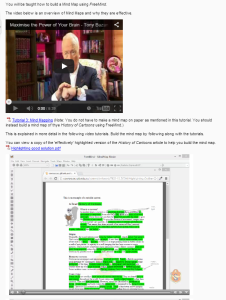Is your Learning Management System paradigm teacher- or student-centered? Long-term success depends upon the correct answer.
 Many educators now accept the need to provide course materials online in a Learning Management System (LMS) or Online Learning Environment (OLE) for blended learning to occur successfully. This allows students to review learning materials at any time and from anywhere, and it opens significant other possibilities.
Many educators now accept the need to provide course materials online in a Learning Management System (LMS) or Online Learning Environment (OLE) for blended learning to occur successfully. This allows students to review learning materials at any time and from anywhere, and it opens significant other possibilities.
However, this is only part of the solution as we move toward blended learning. Building these resources and online courses with an effective paradigm as the guiding force is also vital. Without this, we are simply moving an old industrial model to a different medium.
An incorrect paradigm might appear to be subtly different, but the ramifications can be large and long lasting. A historical analogy helps to clarify this.
Humanity thought the Earth was the center of the solar system for thousands of years. This produced errors in calendars, our understanding of the dates of the seasons and thus the time to plant crops, and later, our understanding of the motion of the planets. Simply changing the sun to the center of the solar system rectified this.
Who you have placed at the center of your online course development is similar; it will affect the long-term success of your move to blended or online learning.
There are two basic paradigms: teacher-centric and student-centric.
(Next page: Comparing these two paradigms—and the indicators for each)
The teacher-centric paradigm
This paradigm assumes that the materials placed in an OLE are primarily there to support the teacher and the teaching process.
This paradigm has a few indicators. Some of these include:
- Resources are present primarily so they can be used by the teacher for “teaching,” and thus are often not “stand-alone.” One example would be a presentation, such as something created in PowerPoint, that could be used by the teacher to “teach” a topic to the class, probably from a whiteboard using a projector.
- Resources in these courses also can be part of a “repository,” with little explanation of what the resources are or what they teach. Sometimes file names are a clue, but sometimes they aren’t.
- Navigation of materials and courses is difficult, as the structure might not be clear to the student; it requires the teacher to provide clarification.
- “Context” is absent or is minimal, making it difficult for a student to understand what is required or where to proceed to next without guidance from the teacher. (“Context” is explanatory text that provides guidance and explanation for the resources.)
The following image has been created as an exemplar for this section of this article. It shows a page ( a segment of a course) on Financial Mathematics. It is simply a collection of files, mainly PowerPoint presentations, with no explanation of…
- What information the files contain.
- What order they should be viewed in.
- How to use them.
- What alternative resources are also available.
The presentations have no narration or explanation, and thus require significant understanding of the topic by the user. The “narration” or explanation has to come from the teacher when he or she “teaches” the material in class, but is not available to a student at any other time or place. Without the teacher being present and taking the time to explain the concepts during the presentation, learning is difficult.
(Note: The Listen button in the screen grab from the LMS shown below is ReadSpeaker, a text-to-speech application.)
The student-centric paradigm
This paradigm assumes that the materials placed in an OLE are primarily there to support the student and learning (as compared to teaching); everything is student-centered. This requires much more than simply being a repository of resources. It requires structure and explanation; it requires the course materials to be presented in a way that allows a student to navigate and understand without the teacher being present to act as a navigational guide.
A student who has not been present in a physical class should be able to continue to learn without confusion—without any increase in cognitive load. A student who is reviewing the material at home should be able to easily comprehend the topic. All of his or her cognitive efforts should be focused on learning, rather than trying to work out…
- What to do.
- Where to locate resources.
- What resource should be used next.
- What a particular resource is there for—and all those other confusing things that can occur in courses.
The following image is a screen shot from another course. It has been designed with the learner in mind.
It contains…
- Context (text that explains the information).
- Sequencing (the sequence for effective learning of the concepts is obvious).
- A variety of resources. (There are videos, documents, and more that are not visible in this screen shot.)
- More effective presentation and formatting of learning resources, and thus is more inviting for learners.
Conclusion
The best LMS or OLE in the world can fail to deliver improved learning outcomes if the courses are poorly designed and implemented from a learning perspective. For the experience to be effective, the educator designing the course should constantly ensure that the student and learning are at the center of the paradigm, rather than the teacher and teaching. Asking the following questions can help with this:
- Is this course designed to be easy for the student to understand by himself or herself? Are the navigation and the sequence of the learning materials easy and obvious? Is there sufficient context or explanation surrounding the learning resources?
- Is each learning resource self-contained? Can a student use the resource independently and understand what is being explained, or will he or she require assistance from a teacher?
- Is the range of learning materials sufficient? Are different learning styles catered for? Are there resources that provide alternative methods of explanation for those students who need this?
By successfully answering these questions, and by ensuring that they are placing the student at the center of the paradigm, educators can build online courses that will be used effectively by students to enhance learning. That, in turn, will help educators take blended or online learning to the next level—where the teacher can focus on the higher-order aspects of learning and the more personalized aspects of teaching.
Peter West is Director of eLearning at Saint Stephen’s College in Australia. He has over 15 years’ experience leading K-12 schools in technology enhanced education, particularly blended learning using online learning environments. He can be contacted at pwest@ssc.qld.edu.au.
- The traditional classroom works so why change it? - February 23, 2017
- Are outdated computers reverting students to a prehistoric era? - November 17, 2016
- Blended learning and the paradox of the experienced teacher - September 30, 2014



